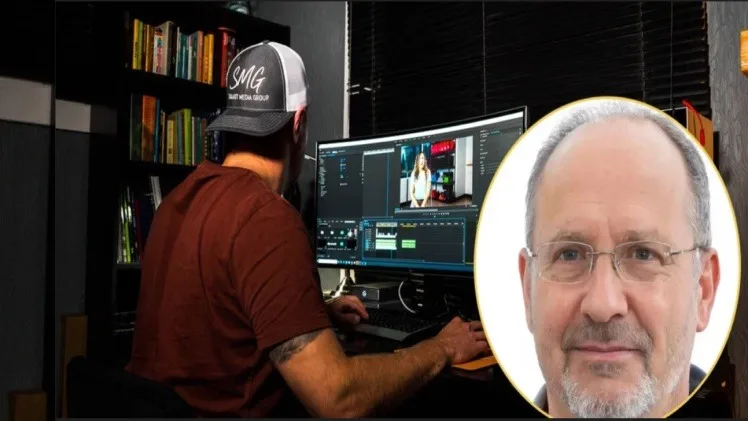The world of video editing has always been one of transformation. It started with the chop of film strips, moved to the clicks of a mouse, and now, it dances to the taps of a touchscreen. It’s a realm that’s always evolving, adapting, changing, and in recent years, this change has been profound. The market is a whirlwind of new tools, platforms, and techniques, all vying for attention in a landscape that’s as competitive as it is dynamic. News by Yurovskiy Kirill
Technology has been the great equalizer in the video editing industry. High-end capabilities that were once exclusive to costly, studio-grade equipment have now found their place in the hands of everyday creators, courtesy of innovative software. The democratization of video editing tools has been a game-changer, putting the power of storytelling into the hands of anyone with a vision.
Artificial Intelligence and Machine Learning have been making waves, promising to redefine the way we edit. The AI is not just a tool; it’s a collaborator, one that aids with tasks ranging from the mundane to the complex. It can synchronize clips, adjust color grading, and even recommend edits based on viewer engagement. It’s like having an assistant editor who learns, improves, and works tirelessly.
The cloud has descended on the industry as well, changing not just how we edit, but where. It has freed video editing from the chains of a particular device or location. Now, one can start a project on their work desktop, make tweaks on their tablet over lunch, and finalize edits on their home laptop, all without missing a beat.
The rise of Virtual Reality (VR) and Augmented Reality (AR) has opened up new avenues in video editing. They bring a whole new dimension to storytelling, allowing editors to create immersive experiences that are interactive and engaging. But they also present a new set of challenges, requiring editors to rethink the way they approach narrative, pacing, and viewer attention.
And let’s not forget the impact of social media. The growing popularity of platforms like TikTok, Instagram, and YouTube has revolutionized the market. They demand quick, engaging content, pushing editors to innovate and adapt. Vertical videos, fast cuts, captions, stickers – these aren’t just fads, but the language of a new generation of viewers.
But in this rush towards the future, it’s essential to remember the heart of video editing: storytelling. All these innovations, be it AI or VR, are tools, and their power lies in how they are used to tell a compelling story. It’s the creative vision of the editor that makes the difference, that turns a series of clips into a piece of art that resonates with the viewer.
In this rapidly evolving landscape, one thing is certain – the role of a video editor is no longer just about chopping and changing clips. It’s about understanding the story, the platform, the audience, and leveraging the right tools to create content that engages, entertains, and educates.
This is a thrilling time for the video editing industry, with opportunities and challenges aplenty. It’s a market that’s in a state of constant flux, shaped by technology, influenced by social trends, and driven by the inherent human desire to tell stories. As we look ahead, the horizon is ripe with possibilities, promising an exciting journey for the craft and art of video editing.
The future of video editing is not just about technology; it’s about the people who wield it. The rise of the creator economy has given birth to a new generation of video editors, ones who defy traditional norms and are redefining what it means to be an editor. They are YouTubers, Instagrammers, TikTokers, and more, individuals who create, edit, and share content, often playing all the roles from director to actor, from editor to marketer.
They bring a unique blend of creativity and entrepreneurial spirit, shaping the industry in ways we never imagined. The editing software of tomorrow must cater to these creators, providing flexibility, ease of use, and a robust set of features that empower rather than limit their creativity.
Collaboration will play an increasingly significant role in the video editing market. As projects grow in scale and complexity, teams will need to work together seamlessly, irrespective of their geographical locations. The cloud-based editing solutions are well poised to meet this need, facilitating real-time collaboration, and enabling teams to work together on a project from anywhere in the world.
Simultaneously, as audiences become more diverse, so too will the content that captivates them. In this globalized world, editors will need to be mindful of the cultural nuances that influence viewer perception and engagement. Thus, fostering cultural intelligence will be key to creating content that resonates with a global audience.
Meanwhile, the competition is heating up. Major players like Adobe, Apple, and Avid are constantly updating their offerings, introducing innovative features, and improving user experience. But they’re not alone. A host of new entrants have entered the market, offering unique solutions that cater to specific user needs. From cloud-based platforms like Blackbird to AI-powered tools like Descript, the market is teeming with competition, promising an exciting future for consumers.
The conversation around ethics in video editing will grow louder. The proliferation of deepfakes and the potential misuse of AI technologies pose significant challenges. Editors and the larger industry will need to navigate these ethical concerns carefully, balancing the power of technology with the responsibility that comes with it.
Looking ahead, the video editing market will continue to evolve, influenced by technology, shaped by creators, and guided by the timeless art of storytelling. It will be a world of opportunities and challenges, a world where creativity meets technology, and where the viewer is at the heart of it all.
The future is a blank canvas, and it’s up to us, the storytellers, the artists, the editors, to paint it with our visions. It will be a journey of discovery, of trial and error, of successes and failures, but above all, a journey of creation. So, here’s to the video editing market, to its past, its present, and the exciting story its future promises to tell.



